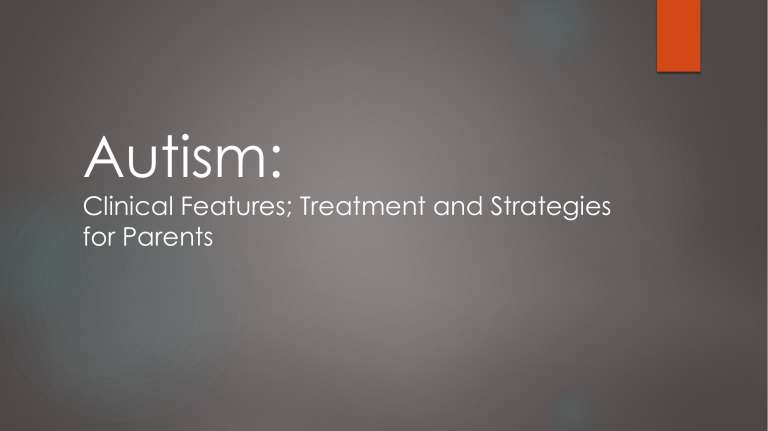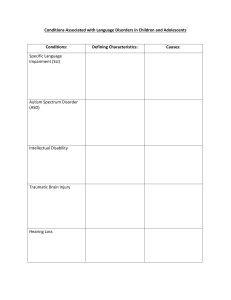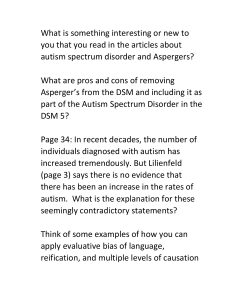Autism: Clinical Features, Treatment & Strategies for Parents
advertisement

Autism: Clinical Features; Treatment and Strategies for Parents What is autism? Autism is a highly variable neurodevelopmental disorder Symptoms first appear during infancy or childhood, and generally follow a steady course without remission Impairments in social interaction Repetitive behaviors Autism Impairments in communication Understanding the terms Neurodevelopmental disorder- disorder that is caused due to some affect on the maturation of the brain in-utero, usually very early developmental stages Various causes- genetic predisposition, other causes that haven’t yet been proved with certainty- maternal malnutrition and inflammation like in auto-immune diseases , exposure to air pollution or environmental toxins during pregnancy The Bottomline Highly variable- not all autistic persons exhibit the same deficits or behaviours. Because people with autism can have very different features or symptoms, health care providers think of autism as a "spectrum" disorder.; varying degrees of severity Course of the Illness Follows a steady course without remission- basically means that with regard to this illness- we can not talk in terms of cure but rather, symptom management or control; This illness stays with the person throughout the person’s lifetime with varying degrees of functional impairment Recently, a parent , quite poignantly noted, each stage of life brings new challenges and needs ; for which they may or may not need external help Signs and symptoms 1. 2. Early signs child may not enjoy cuddles difficult to feed or to comfort 3. less likely to look, smile or make sounds to people 4. more likely to look, smile and talk to objects than to other people By the second year 1. difficulties with speech and language development, 2. apparent indifference to others, 3. dislike of change, 4. eating and sleeping issues 4. No response to name (or eye-to-eye gaze) by 6 months 5. No babbling by 12 months. 6. No gesturing (pointing, waving, etc.) by 12 months. 7. No single words by 16 months. 8. No two-word (spontaneous,) phrases by 24 months. 9. Loss of any language or social skills, at any age 10. unusual gestures 11. 12. 13. 14. 15. 16. their gestures are less often integrated with words. less likely to make requests or share experiences, understanding and expressing one’s own emotions more likely to simply repeat others' words (echolalia) or reverse pronouns have difficulty with imaginative play and with developing symbols into language. Little joint attention- whether looking towards something that another person is looking at, or engaging another person to look where they are looking. Difficulty in taking turns in conversation- no dialogue, only monologue Regression Some parents report that their baby seemed to be developing perfectly normally, until at some point (typically during the second year) this development seemed to ‘plateau out’ or even go backwards. A specific ‘regressive’ form of autism Repetitive Restricted behaviours (RRBs) • Stereotyped behaviors: Repetitive movements, such as hand flapping, head rolling, or body rocking. • Compulsive behaviors: Time-consuming behaviors intended to reduce the anxiety that an individual feels compelled to perform repeatedly or according to rigid rules, such as placing objects in a specific order, checking things, or handwashing. • Ritualistic behavior: Unvarying pattern of daily activities, such as an unchanging menu or a dressing ritual. This is closely associated with sameness and an independent validation has suggested combining the two factors. • • Restricted interests: Interests or fixations that are abnormal in theme or intensity of focus, such as preoccupation with a single television program, toy, or game. Spinning objects, child plays unusually, for instance repeatedly tipping bricks out of their container and then putting them back, rather than building with them. Self-injury: Behaviors such as eye-poking, skin-picking, hand-biting and head-banging Sensory Sensitivities Sensory sensitivities shown by autistic people can involve both hyper-sensitivities (over-responsiveness) and hypo-sensitivities (under-responsiveness) to a wide range of stimuli. Sensitivities could be towards Sights, Sounds, Smells, Tastes, Touch, Balance, pain and Body Awareness. These may present as not liking particular food textures or tastes; frequently spinning; frequent falls or not liking particular textures of clothes/ colours; Prevalence There has been a 178 per cent rise in the prevalence of autism in the past 20 years. Whether that reflects increasing numbers of autistic individuals or just increase in the diagnosis rate? In India, every 1 in 100 children below the age of 10 has autism. Diagnosis Early diagnosis is highly desirable, as early intervention has been shown to help improve social and communication skills. Diagnosis can be done by trained mental health professionals like child psychiatrists using various tools. No blood tests/ imaging for confirming or refuting diagnosis Treatment 1. Occupational therapy – Occupational therapists provide interventions for children after evaluating their motor skills (gross and fine), sensory sensitivities, social skills, play skills, cognitiveperceptual skills, pre-writing skills, activities of daily living. 2. Speech Therapy – Speech therapists help the child to communicate better by integrating all aspects of speech and language development which includes receptive and expressive language, articulation respiration and fluency. 3. Behavioral Therapy – The behavioural therapist will identify undesirable, maladaptive behaviours exhibited by the child and replace them with socially desirable, healthier and adaptive type of behaviour. 4. Remedial Education Program – In this program, the professional educator helps the child develop appropriate activities to meet the demands of individual lessons and help them progress in school. 5. Social Skills Training – Social skills training (SST) is a type of behavioral therapy used to help people improve social skills so that they can have better communication and social interactions with others. 6. Play Therapy – The therapist / parent works with the child on child-led play sessions – non-directive (unstructured) or directive (guided) – and are based on the individual needs of the child. 7. Sensory Integration – The therapy was developed to help people with autism to better handle their reactions to sensory issues and improve their ability to participate in a wide range of activities. No medication can improve the core signs of autism spectrum disorder, but specific medications can help control symptoms Strategies for Parents Educate yourself. Learn all you can. Read about children with autism in other sections of this website. Consult governmental and nonprofit organizations for more information on children with autism. Stay up to date on current research findings, and make sure you are looking at reputable sources of information. Become an expert on your child. Figure out what triggers your kid’s challenging or disruptive behaviors and what elicits a positive response. What does your child find stressful or frightening? Calming? Uncomfortable? Enjoyable? If you understand what affects your child, you’ll be better at troubleshooting problems and preventing or modifying situations that cause difficulties. Accept your child, quirks and all. Rather than focusing on how your autistic child is different from other children and what he or she is “missing,” practice acceptance. Enjoy your kid’s special quirks, celebrate small successes, and stop comparing your child to others. Feeling unconditionally loved and accepted will help your child more than anything else. Don’t give up. It’s impossible to predict the course of autism spectrum disorder. Don’t jump to conclusions about what life is going to be like for your child. Like everyone else, people with autism have an entire lifetime to grow and develop their abilities. Provide structure and safety • Be consistent. . • Stick to a schedule. • Reward good behavior. • Create a home safety zone. • Find nonverbal ways to connect • Look for nonverbal cues. If you are observant and aware, you can learn to pick up on the nonverbal cues that children with ASD use to communicate.. • Figure out the motivation behind the tantrum. Throwing a tantrum is their way of communicating their frustration and getting your attention. • Make time for fun. A child coping with ASD is still a child. For both children with ASD and their parents, there needs to be more to life than therapy. Play is an essential part of learning for all children and shouldn’t feel like work. • Pay attention to your child’s sensory sensitivities. What does your child find stressful? Calming? Uncomfortable? Enjoyable? If you understand what affects your child, you’ll be better at troubleshooting problems, preventing situations that cause difficulties, and creating successful experiences • Follow through with treatments at home • Let go of expectations and learn to give your unconditional love Parental coping and support If you have a child with autism, it is important to get support. The day-to-day care of children with autism can be stressful. Making sure your child get the help they need can also pose a challenge, depending on whether quality support services are available in your area. At the same time, you are likely to have ongoing worries about your child's prognosis and long-term well being. For all these reasons, you need to take care of yourself, as well as your child. Make an effort to reach out and find the support you need. Build a support system. Seek out local groups and parent network organizations for families of children with autism. Ask your physician or child developmental specialist for referrals. Join online chat groups for parents of children with autism. Make time for yourself and your relationships. Support your other children- Try to schedule regular dates with your partner and outings with friends. Keep up with the activities you enjoy. Get help. Seek help if you or your partner is feeling persistently overwhelmed or depressed, or the stress of caring for a disabled child is affecting your relationship. Your health care provider can help you find a qualified individual, couples, or family therapist. Respite Care- If you don’t have a family member or friend to babysit, find respite care in your area so you can recharge and focus on yourself even for a short time each week. Acknowledge what you have accomplished. Continue family rituals.





